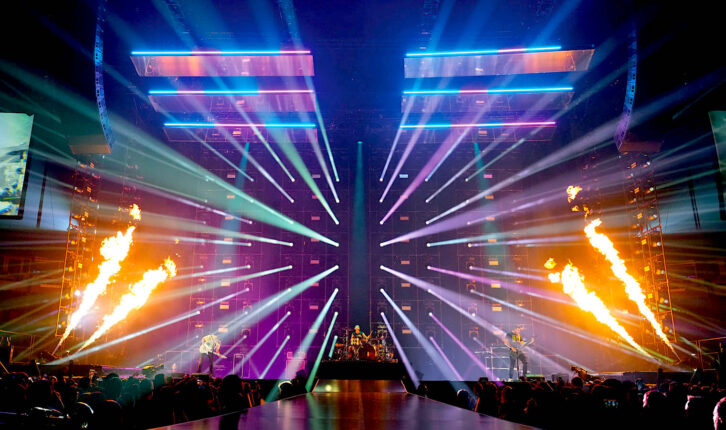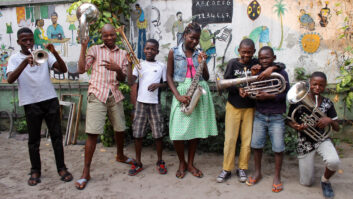Still delivering a satisfying mix of rock, electronica and sci-fi nearly 30 years after forming, Muse has been packing arenas and festivals around the world on its current tour behind the new Will of the People album. The epic shows reflect the album’s big themes and even bigger hooks, but the journey itself started small, inside Exeter’s Cavern Club in the south of England, over a year ago.
“It was the original club where the band played their first show—a 200-capacity venue,” said Marc Carolan, the band’s FOH engineer since 2001. That was followed by the 2022 Summer festival season, a Fall full of theater underplays around the globe, and now a five-month North American arena leg that ended this month in Atlanta. “What I love with Muse is they’ve still got the ability to completely blow a club show apart,” Carolan said with a grin. “It’s the same with the theaters, too, so although they’re renowned for their large productions, they can strip that all away and they’ve still got it.”

Muse has long been known for shows that are a visual feast—a typical evening on the band’s current arena run features jaw-dropping amounts of lasers, pyro, giant inflatables, confetti (so much confetti!) and more—but if Muse is set on indeed listening to the will of the people and overdelivering on concert theatrics, the same goes for its approach to audio.
Muse’s longtime audio provider is UK-based Skan, which was acquired by Britannia Row and Clair Global last fall; the team ensuring everything audio surpasses audience expectations includes monitor engineer Matt Napier, on his first tour with the group; crew chief, RF guru and monitor assistant Liam Tucker; FOH minder/secondary systems engineer Eddie O’Brien; system engineer Matt Besford-Foster; system tech Rob Wilkins; and comms tech Boden Birkett.
FOH FOUNDATIONS
Carolan’s FOH position is a fortress of the old and the new, centered around an Avid S6L digital console flanked on either side by racks of outboard gear, all tackling the music generated on stage by vocalist/guitarist Matt Bellamy, bassist/vocalist Chris Wolstenholme and drummer Dominic Howard, with touring musician Dan Lancaster.
Some of the front-of-house outboard gear has done multiple circuits around the world with Muse, but it all has to earn its keep, said Carolan: “There are pieces that work, that sound good and bring something to the party, but I’ll often ‘blind A/B’ things, because I want to know if I’m fooling myself thinking this analog choice is better than a plug-in choice. With the outboard effects that I still carry, like the Bricasti M7s and the Eventide H3000, there are plug-in equivalents, but there aren’t any as good as the real thing—so we carry the real thing.”
Other outboard gear filling the FOH racks includes a Rupert Neve Designs 5059 Satellite summing mixer; a UBK Fatso; a Maag Audio EQ4M; a GML 8200 parametric EQ; Empirical Labs EL8-X Distressors and Fatso EL7Xs; a Klark-Teknik BBD-320 signal processor; Midas XL42 channel strip preamps; Yamaha SPX2000s; dbx 160A and Tube-Tech LCA 2B compressor/ limiters, as well as an SMC 2B multiband opto compressor; and a SPL Transient Designer.
Inside Muse’s 2010 ‘Uprising’ Tour
Still, there’s plenty going on with plug-ins, too, not least that Carolan has shifted to using audiostrom LiveProfessor to host them all. “The full suite of what I would use in studio mixing is all available to me now, so I have quite a few Softube plug-ins, FabFilter, iZotope and some McDSP, especially the AE600 Active EQ,” he said, adding that he’s been beta-testing the newly released okesound Soothe Live dynamic resonance suppressor plug-in. “That’s going to be a real game-changer on the S6L platform,” he averred. Sometimes the plug-ins win those aforementioned A/B tests, too: An Avalon VT-737sp hardware unit used in the past for vocal distortion on Bellamy gave way to a UAD-based plug-in version this time around.
One of the biggest changes in the band’s live sound on the current tour comes not from Front of House but from the stage itself, as Bellamy and Wolstenholme have switched to using Fractal AXE-FXIII preamp/fx processors. Band studio engineer Aleks Von Korff and guitar tech Chris Whitemyer spent months modeling the group’s gear to make it happen. “It’s not an easy, off-the-shelf decision that they’ve made, but they sound great,” said Carolan. “The sounds are slightly different—and better—even in the legacy songs, so that brings a new energy to them.”
MIKING MUSE
A/B testing wasn’t solely the province of FOH; that’s how the switch to Fractals happened and it also affected some miking, as monitor engineer Matt Napier noted, leading to an AKG D12 VR taking the kick drum spot and a move to Austrian Audio OD7s on Toms.
When it came to Bellamy’s vocal microphone, however, an A/B test made clear it was best to go with not one mic or the other, but both. The singer has long belted into a Neumann KMS 105 onstage, and as the survivor of countless tests over the years, it’s the best match for his voice. However, he spends much of the show out on the thrust and B-stage, far in front of the P.A. “We had good results with the Austrian Audio OD505 out there,” said Napier. “The rejection on that has worked out really well—so we switch mics as needed. It’s choosing what’s best for which song and where he is, rather than compromising and saying we’ll use one mic for everything.”

MUSE’S MONITORWORLD
In monitorworld beneath the stage, Napier mixes on a DiGiCo Quantum7 console, employing a selection of Waves plug-ins, including the Abbey Road TG Mastering Chain (“It has a nice spread function to widen things for the ears”), SSL E-Channel Strip on drums, and SSL G-Master Buss Compressor.
Mixes are sent to the band via Wisycom RF bodypacks. “They’ve particularly helped—even the band noticed—because they’re so much cleaner, especially in the low end,” said Napier.
The band hears its mixes via Westone UM Pro30 earphones, soon to be updated to Pro X30s. “They’ve all got their own individual reasons for not wanting custom molds done and they’re quite happy on the generics,” said Napier. “They sound really good, and speaking as a monitor engineer, it’s brilliant, because I’ve got a drawer full of them and if one breaks, I don’t have to send it back to get fixed; just pull out another set and give it to the band.”
Hanging above the stage is a considerable d&b audiotechnik GSL/KSL line array system, centered around GSL hangs of 18 on the mains and 16 on the sides. Subs are distributed under the stage, and fills are used at the end of the thrust. System engineer Matt Besford-Foster explained, “It provides a focal point so that when you see Matt on the B stage, there’s actually some sound coming from where he is; otherwise, you’ve got this big P.A. blasting away that is disconnected from what’s happening.”
Next on the Muse agenda are more dates in Europe and Malaysia through the end of July, making the most of the pervasive energy running throughout the production. “The band are proud of the sound they’re coming up with,” said Carolan, “so they support us in doing what we think is best for the sound. The overriding concern is the results—the sound of what we’re doing. It’s nice to be working in a camp where audio is as intrinsic as anything else, and that comes from the artists.”







